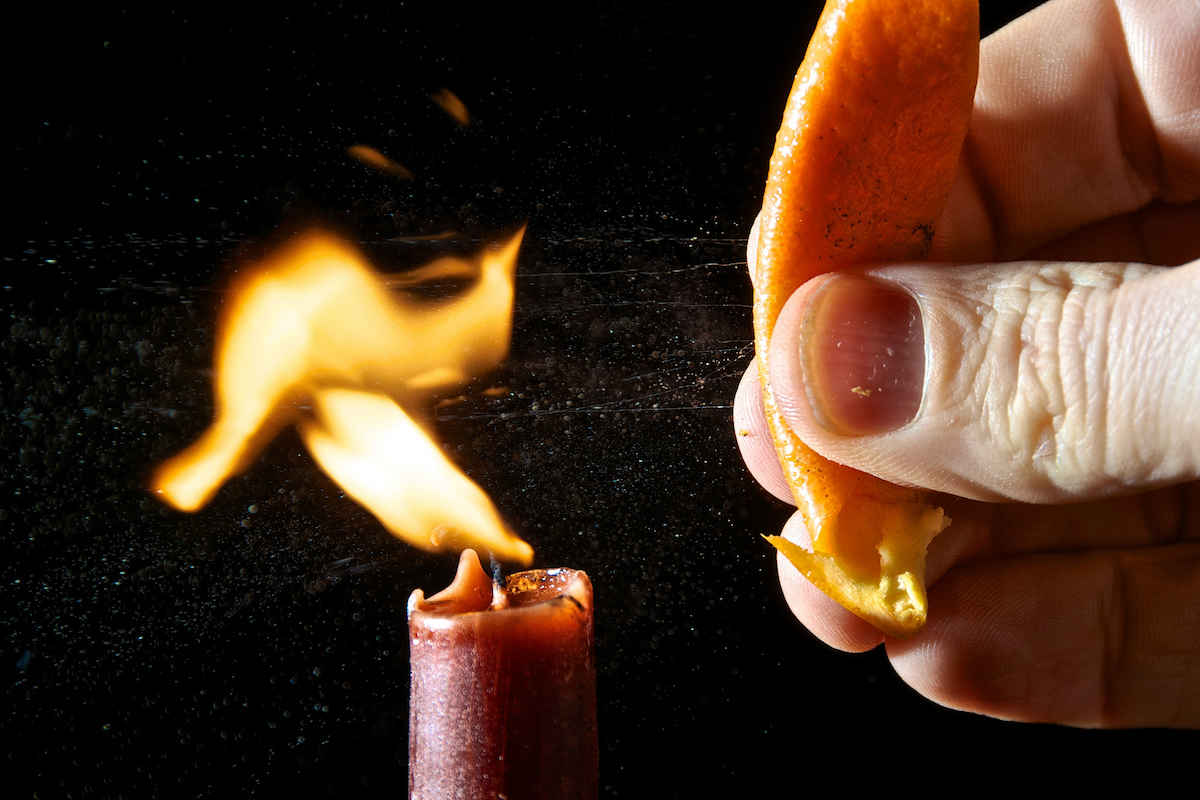Whether it was your Old-Fashioned or a drink ordered halfway down the bar, the pyrotechnic effect from flaming a citrus peel is a conversation-stopper you can’t help but notice. And the burnt, caramelized citrus aroma it leaves behind is one of those memorable moments that can make going out for drinks a little extra special.
Unless you decide to master the trick yourself. In that case, you can impress your friends and make your home smell amazing at the same time.
My search for mastery brought me into contact with Lonnie Newburn, the owner and operator of the Boston Shaker, a cocktail-focused specialty store in Somerville, Massachusetts that regularly offers cocktail classes.
Get Picky About Citrus
The quest for fire begins at the supermarket: to maximize your flame, find a lemon or orange that’s packing a decent amount of oil. Look for dimples, which are really just pockets of citrus oil, so the more bumps the better. The ideal citrus should also have a tougher skin, which allows it to be cut with more precision.
Once you’ve picked your citrus, make sure it’s at least room temperature before removing the peel (for maximum oil extraction, Newburn recommends microwaving it for three to five seconds or running it under hot water). But once a fruit’s been cut, you’ll see diminishing returns. It will begin to degrade and become softer, making it less effective at exuding oil.
Both lemons and oranges can be flamed (limes, not so much) but each have different characteristics. The orange, with its notes of burnt sugar and caramelized fruit, is the most common choice.
“Most people aren’t flaming lemons,” Newburn says. “The orange is darker and has a rich, figgy note. Lemon is lighter and brighter.”
The First Cut (Should Be) the Deepest
So you’ve got your oil-rich lemon or orange on hand, and it’s at room-temp or higher. Now you just need to slice off the peel itself.
Newburn recommends using a Y-peeler, whose shape ensures that you’ll be pulling away from your own fingers. A sharp knife can also be used, but isn’t as ideal.
“The Y-peeler has a space between the blade that allows it to only go so deep into the citrus, so it stays on the outside and doesn’t cut the actual fruit,” says Newburn. “If you’re using a knife, you have to be a little more careful that you don’t cut too deep, because you want this piece to be flexible and able to express oil.”
When peeling, Newburn recommends holding the fruit as if you’re palming a basketball before a free throw: hand raised, fingers vertical and pointed toward the ceiling.
“That way when I peel down and away, my fingers are not below the citrus and I won’t cut my knuckles or skim my fingers,” he says.
Express Yourself

Lonnie Newburn at the Boston Shaker.
Before lighting any matches, be sure that you’ve got the expression side of the equation down pat. To express a citrus peel, gently pick it up (make sure not to pre-pinch) and point the skin side toward the drink. Then pinch it along the center with your fingers, which forces the citrus oil out. The central crease will exude the most oil, but you can keep extracting from the rest of the peel.
“You can pinch each corner and continue to roll that peel around in different sections, causing a crease, and it’ll keep going,” Newburn says. “There’s a lot of oil in there. You can keep flaming an entire peel.”
Light My Fire
After a successful dry run expressing the peel, you’ll be ready for some fireworks. Newburn recommends using matches rather than a lighter, partly to avoid any chemical flavors a lighter might contribute, and partly for better showmanship.
Hold the peel about five inches from the cocktail with your non-dominant hand, then ignite the match with your dominant hand and hold it between peel and cocktail. The amount of flame you get from expressing the citrus over the match partly depends on speed: the faster the pinch, the more explosive the flame.
An alternate method Newburn recommends involves switching hands. To warm your citrus prior to expression, hold the match over the cocktail glass with your non-dominant hand while your dominant hand runs the peel over it, close enough to almost touch the fruit’s skin. Then express that warm, fragrant oil over the drink.
Your cocktail should now have a pleasing citrus aroma, and your making it may have even elicited a few “oohs” and “aahs”—maybe even from you. Feel free to run the post-flame peel around the rim of your glass for even more of that aroma, but Newburn recommends discarding the peel rather than adding it to the drink as garnish, as you may not want the flavors generated from the flaming process sitting in your drink.
By Newburn’s telling, the cocktails that benefit the most from flaming citrus peels are stirred drinks made with aged spirits.
“It’s usually for dark Manhattan variants, things like the Toronto,” Newburn says. “These rich, whiskey-vermouth-and-bitters cocktails that are dark and spiced need this bright, burnt orange to balance them out.”



